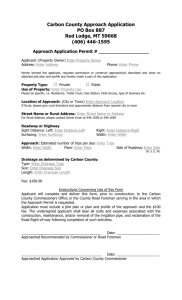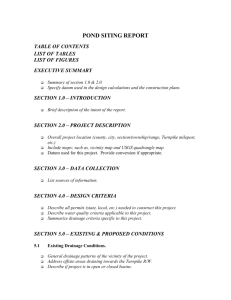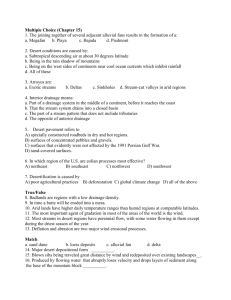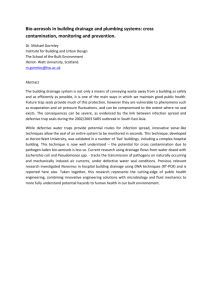Designing Erosion Control on a Thoroughfare Project
advertisement
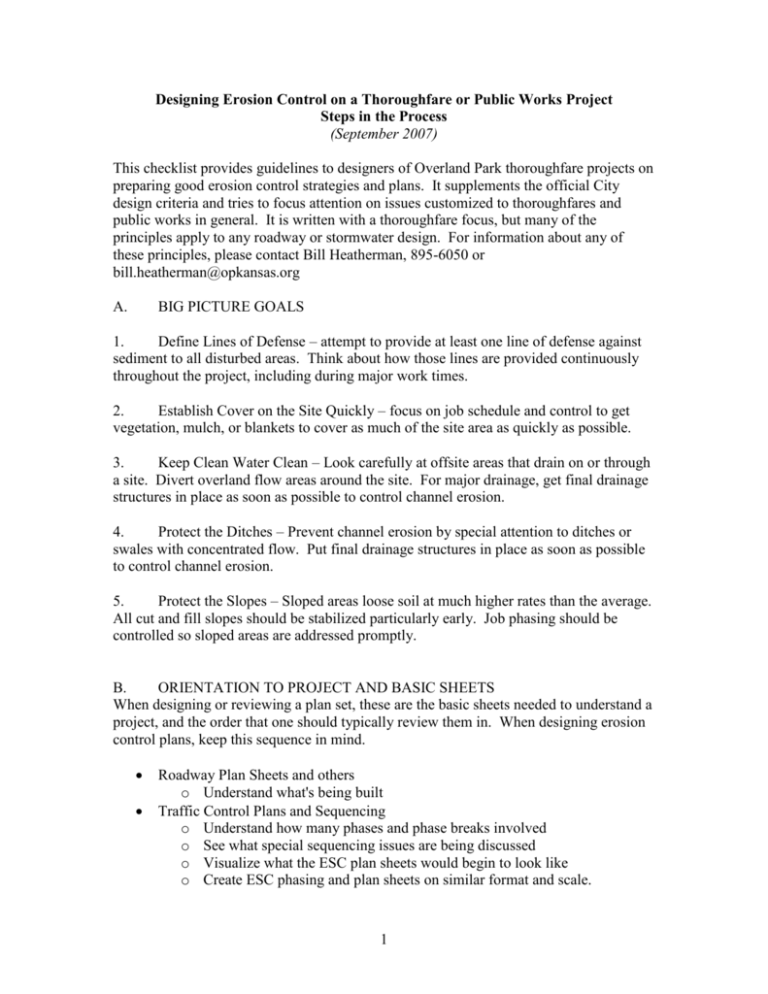
Designing Erosion Control on a Thoroughfare or Public Works Project Steps in the Process (September 2007) This checklist provides guidelines to designers of Overland Park thoroughfare projects on preparing good erosion control strategies and plans. It supplements the official City design criteria and tries to focus attention on issues customized to thoroughfares and public works in general. It is written with a thoroughfare focus, but many of the principles apply to any roadway or stormwater design. For information about any of these principles, please contact Bill Heatherman, 895-6050 or bill.heatherman@opkansas.org A. BIG PICTURE GOALS 1. Define Lines of Defense – attempt to provide at least one line of defense against sediment to all disturbed areas. Think about how those lines are provided continuously throughout the project, including during major work times. 2. Establish Cover on the Site Quickly – focus on job schedule and control to get vegetation, mulch, or blankets to cover as much of the site area as quickly as possible. 3. Keep Clean Water Clean – Look carefully at offsite areas that drain on or through a site. Divert overland flow areas around the site. For major drainage, get final drainage structures in place as soon as possible to control channel erosion. 4. Protect the Ditches – Prevent channel erosion by special attention to ditches or swales with concentrated flow. Put final drainage structures in place as soon as possible to control channel erosion. 5. Protect the Slopes – Sloped areas loose soil at much higher rates than the average. All cut and fill slopes should be stabilized particularly early. Job phasing should be controlled so sloped areas are addressed promptly. B. ORIENTATION TO PROJECT AND BASIC SHEETS When designing or reviewing a plan set, these are the basic sheets needed to understand a project, and the order that one should typically review them in. When designing erosion control plans, keep this sequence in mind. Roadway Plan Sheets and others o Understand what's being built Traffic Control Plans and Sequencing o Understand how many phases and phase breaks involved o See what special sequencing issues are being discussed o Visualize what the ESC plan sheets would begin to look like o Create ESC phasing and plan sheets on similar format and scale. 1 Drainage Area Map o Understand overall drainage patterns o Find sizes of off-site contributing areas o Find large RCBs under roadways o Find discharge points from project o Transfer info onto ESC plan by showing inflow and discharge points and indicated acreage of tributary area at each one. Project Profile o Find crests and sags in proposed profile. o Transfer that information onto ESC plan by placing a line or symbol at each, with station indicated o Use crests to divide project into separate work zones. Each independent zone is designed separately. o Use sags to anticipate where water eventually must pond or leave the roadway and where much of the settlement activity will occur. o Use profile to get a rough initial feel for where large cuts and fills will occur. Cross Sections o For each work zone and phase, review the cross sections carefully to understand how the cuts/fills/disturbances will really look. Best to do this close in look in segments, as BMPs are being placed and decided, rather than trying all at once to understand. o However, the first look is done all at once, scanning quickly from one end of the job to the other to get a feel for the magnitude of earthwork. Cross reference at this point is made between sections and profiles. o Look out for Toes of large embankments Slopes of large embankments Offsite drainage running into the project Offsite drainage running down or over cut lines Temporary or permanent ditches Intermediate slope limits and drainage by phases. o Frequent cross-referencing between existing contours on the ESC sheets and the cross sections is needed to get the overall picture. o I transfer some of this information on to ESC as working notes to guide placement of BMPs. ESC Plans o Formatting: General Place on the ESC sheets Use narrative notes whenever possible. Use simplified symbology as much as possible instead of trying to detailed draw. Make the BMPs stand out. o Provide time limits for critical items. Locate either: As note on ESC Plan Sheet As column in construction sequencing/traffic control pages 2 o Best format seems to be double-decked plan sheets at 1" = 50 scale (full size), 1" = 100' on half size. o Layers to have turned on for sure o Things to leave off o BMPs placement notes and symbols are placed on these drawings. o Summary of quantity sheet is broken by phases. C. GENERALIZED PHASING Thoroughfare sheets are generally phased by partial roadways being built, with smaller sub-phases identified in order to build intersections, build drainage structures, or place temporary paving. Within each phase, there is a predictable sequence of activities: o Utility relocations - beginning before project starts and continues often times throughout. o Major cross-road drainage (culverts and RCBs) installed. Must now include completion of headwalls and placement of rip-rap or other stabilizations. o Removals, clearing, and grubbing. o Place temporary pavements, widenings, and traffic control and move traffic onto interim alignment (if roadway is not closed to traffic). o Initial rough grading - build up large fills, cut down large embankments. o Intermediate rough grading - continue earthwork to get roadway and slopes to rough grade. o Storm sewer and inlet goes concurrent with intermediate rough grading, but after the initial is complete o Finish grading of slopes outside right of way line. o Grade and stabilize any ditches. o Fine grading of roadway subgrade o Underdrain placement o Placement of curb and gutter and curb inlet throats and tops. o Fly-ash stabilization of subgrade o Placement of OP Special Base Course o Pave the base coarse o Place temporary pavement markings o Open select elements to traffic o Place foundation and pave driveways o Install street lights o Install traffic signals o Install sidewalks o Install ADA curb ramps o Sod or final seeding. o Install pavement markings o Install traffic signs. 3 o Open to full traffic. D. SELECTING AND PLACING BMPs Build major cross-road drainage first, before getting too deep into adjacent work (including clearing). Handle water during cross-road drainage construction as best as possible. Divert or re-align stream whenever possible. Finish cross road drainage before moving on, including placement of headwalls and inlet/outlet rip-rap. Get temporary construction entrances built. Use silt fence as diversion barrier for offsite areas to keep from draining into site. Put in place before starting work. Use silt fence to create pockets to settle water at toes of large embankments. Put in place before starting embankment At cross-road drainage structures, typically need a separate pocket at all 4 corners of the cross road pipe, so that offsite channelized water doesn't interact with pocket. Provide rock ditch check in channel at completion of project. During major grading phases, keep rock on hand to create "rock swale checks". Use silt fence to keep offsite flow out of temporary ditches, but instead run those parallel to the temp ditch. Hydromulch or seeding temporary ditches very early in the process. Stabilize temporary ditches with rock ditch checks, silt fence, and/or geo-ridges. Get storm sewer runs built as quickly as possible. Specify particularly high-value runs for rapid construction, these are the trunk lines that pick up the major offsite areas. Run water into area inlets and open-topped curb inlets absolutely as soon as possible, but provide a small amount of settling before hand. This means each inlet must have an initial weir-barrier to achieve settlement, along with a larger "backstop" to prevent slightly ponded water from bypassing. Inlets generally protected by leaving ground around low, blocking up with board, and having rock or silt fence "backstop". Continue looking for creative ideas on handling temporary gutters and guides to get water into inlet. Where street is in cut, use top of slope berms to bring offsite water to temporary slope drains, then run slope drains down the hill into the curb inlets. Finished slopes outside the right of way as soon as possible. If larger than 5-6' vertically, use straw blanket and straw wattles along face. Hydroseed. Use multiple little rock swale checks, wattles, berms, etc to control erosion during the sub-grade preparation phase. This is the hardest stage of construction since the roadway must be kept flat and unobstructed so that base course can be placed on it. It's also problematic since we don't want to pond water directly on it, since that would damage the durability and strength of the subgrade. Getting through this phase quickly is key. 4


